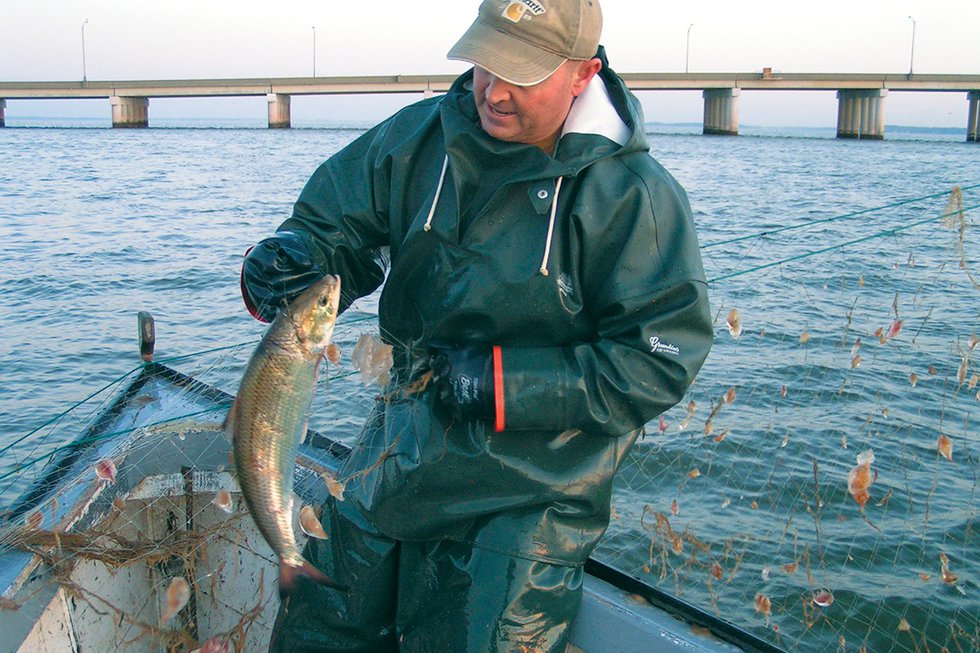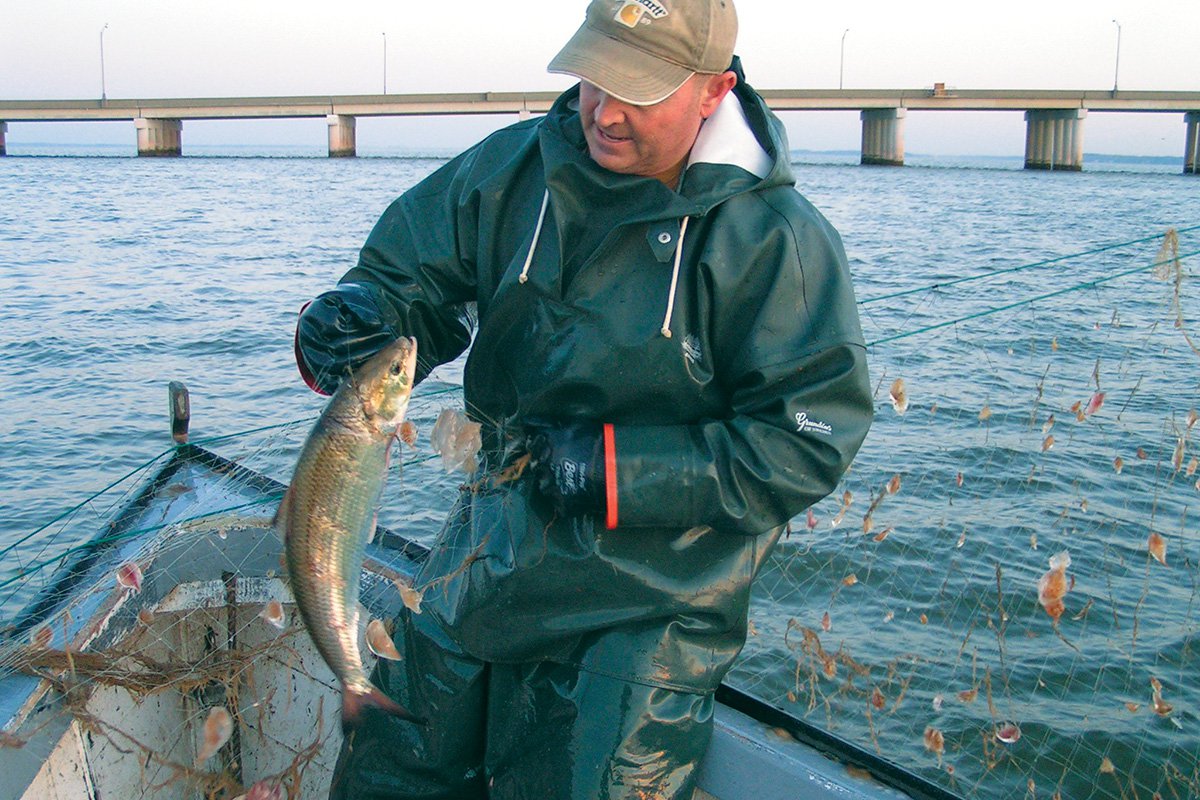
For greater than 200 years, the inhabitants of American shad within the James River has been steadily declining. However a brand new effort hopes to lastly reverse that pattern.
The American shad lives most of its life within the salt waters of the North Atlantic, but it surely’s born proper right here in Richmond. Every spring, grownup shad swim inland to spawn in freshwater rivers from Florida to Newfoundland. Juveniles are a wealthy supply of vitality within the aquatic meals chain, and for hundreds of years the American shad was one of the crucial commercially precious and culinarily coveted species on the East Coast.
For the reason that Nineteen Nineties, scientists and lecturers have been making an attempt to revive shad populations, and in 1992 what’s now the Virginia Division of Wildlife Assets opened a shad hatchery. For over 25 years, this system stocked the James with greater than 125 million shad fry, hatchlings which might be developed sufficient to feed on plankton. Two years after the hatchery was opened, the DWR prohibited shad harvesting. In 1999, a fish ladder was launched in Bosher’s Dam simply west of Richmond to permit higher entry to spawning habitats. However to this point, the three a long time of labor to get well the American shad within the James River have failed.
Although there’s consensus concerning the issues contributing to the decline of the shad inhabitants — offshore business fishing, water air pollution, limitations to migration, habitat degradation, the predation of invasive species (such because the blue catfish) and industrial water intakes — the rationale tried options haven’t been profitable has to this point eluded scientists and lecturers.
The Virginia Institute of Marine Science has been monitoring the inhabitants for 25 years, says Eric Hilton, who runs its American shad and river herring monitoring program. “We will very rigorously and demonstrably present that the populations are disappearing to the purpose that, in our survey within the spring of 2023, we caught no feminine American shad.”
The DWR additionally displays fish populations by counting passage via the fishway at Bosher’s Dam, and their counts are simply as gloomy. Fewer than 50 American shad have handed via the fishway yearly since 2016. DWR estimates that just one was noticed in 2019. For comparability: About 3,300 American shad have handed via the fishway since 1999, whereas 2.3 million gizzard shad had been seen in the identical spot in the identical time frame.
Hilton is main a venture which will flip the pattern. With $290,000 awarded by the Common Meeting and secured by the James River Affiliation, he has spent the final yr drafting a plan to get well the American shad.
Shad populations in states alongside the Japanese Seaboard have been scarce because the mid 2000s. The U.S. Fish and Wildlife Service has been working for years to take away dams that stop migratory fish passage, and in 2020 it eliminated 73 of them within the Northeast, opening migration routes from Virginia to Maine. Maryland took measures within the Eighties and ’90s by closing a fishery, mitigating air pollution and opening a fish passage, however to no avail; there simply weren’t sufficient adults to breed. In 2005, an article in The New York Occasions declared that the shad inhabitants in Connecticut could have been at its lowest in 25 years, citing one biologist who speculated that striped bass being restocked alongside the East Coast had been gobbling up each adults and juveniles.
Although makes an attempt to reinvigorate American shad within the James have by no means actually stopped, some, such because the hatchery program, have been placed on hiatus. “It made sense to throw the whole lot at them we might: the stocking, the moratorium and the fish passage,” Alan Weaver on the DWR says. “Hopefully, that was going to increase their spawning vary, which it did, but it surely clearly wasn’t sufficient.”
“We have to discover out what else is inflicting the issue earlier than we proceed to inventory,” he says.
Final October, VIMS convened a committee of specialists from the pure assets neighborhood — together with state environmental and wildlife businesses, college researchers, and leaders from the Pamunkey and Mattaponi tribes — for a gathering to debate believed causes and potential options.
For the previous yr, Hilton has been compiling their concepts, analysis and suggestions right into a report. The Virginia Coastal Coverage Heart is drafting suggestions for authorized insurance policies that help restoration. In July, VIMS started testing a brand new sonar system to gather information concerning the well being of the shad’s habitat within the James.
Hilton plans to take the report again to the pure assets neighborhood for suggestions earlier than presenting it to the Common Meeting this fall.
The proposal has 4 components: First is to proceed the monitoring program to assist measure the progress of restoration tasks. The second is to analyze the reason for the shad’s excessive mortality charges — is it the predatory blue catfish? Catching offshore? Floor water intakes? Third, Hilton says they’ll suggest reopening the hatchery. And lastly, he says we’d like extra analysis on how local weather change is impacting shad.
“Within the Nineteen Nineties, I don’t suppose anybody absolutely appreciated the local weather change angle,” Hilton says, referring to information exhibiting that the waters of the James, the Chesapeake Bay and the entire North Atlantic are rising in temperature. Hilton speculates that, consequently, the American shad that do return to spawn within the James arrive in dangerous form. “There’s some proof that we’re not getting older, more healthy fish coming again. The perfect improvement temperature for eggs is in a reasonably slim window, so once you get increased than that, it’d induce a poor yr.”
A cynic would possibly name Hilton’s suggestions extra of the identical, however he’s positive that persevering with a number of the previous tasks (with tweaks) and including new ones will make a distinction. There are some components additional tasks may have little management over, like local weather change, however, Hilton says, “I do consider that the suggestions we’re proposing will assist, however to be really efficient, these will should be thought-about collectively.”
Though previous tasks had been properly knowledgeable, there was no formal plan for shad restoration within the Nineteen Nineties, says Invoice Avenue, president and CEO of the James River Affiliation. He believes getting consensus amongst environmental specialists will make a stronger case to policymakers. “They [can] have the arrogance that that is one thing that’s backed up by the very best science obtainable,” he says. “We hope that may speed up and push our efforts ahead.”
What if the inhabitants collapses? Marine migrants just like the American shad enrich inland freshwater techniques. “With a wholesome run, they’re contributing an enormous quantity of marine-derived vitamins into a comparatively much less productive freshwater system. If you happen to lose that, then you definitely lose all these major feeders on the meals net,” Weaver says. However, given the prospect, American shad are prolific spawners. “If you happen to give them the chance and shield them, and if they’ve the habitat from spawning to rearing to out-migration to the time within the saltwater surroundings, in the event that they’re protected and so they get the assets they want, they’ll come again.”

